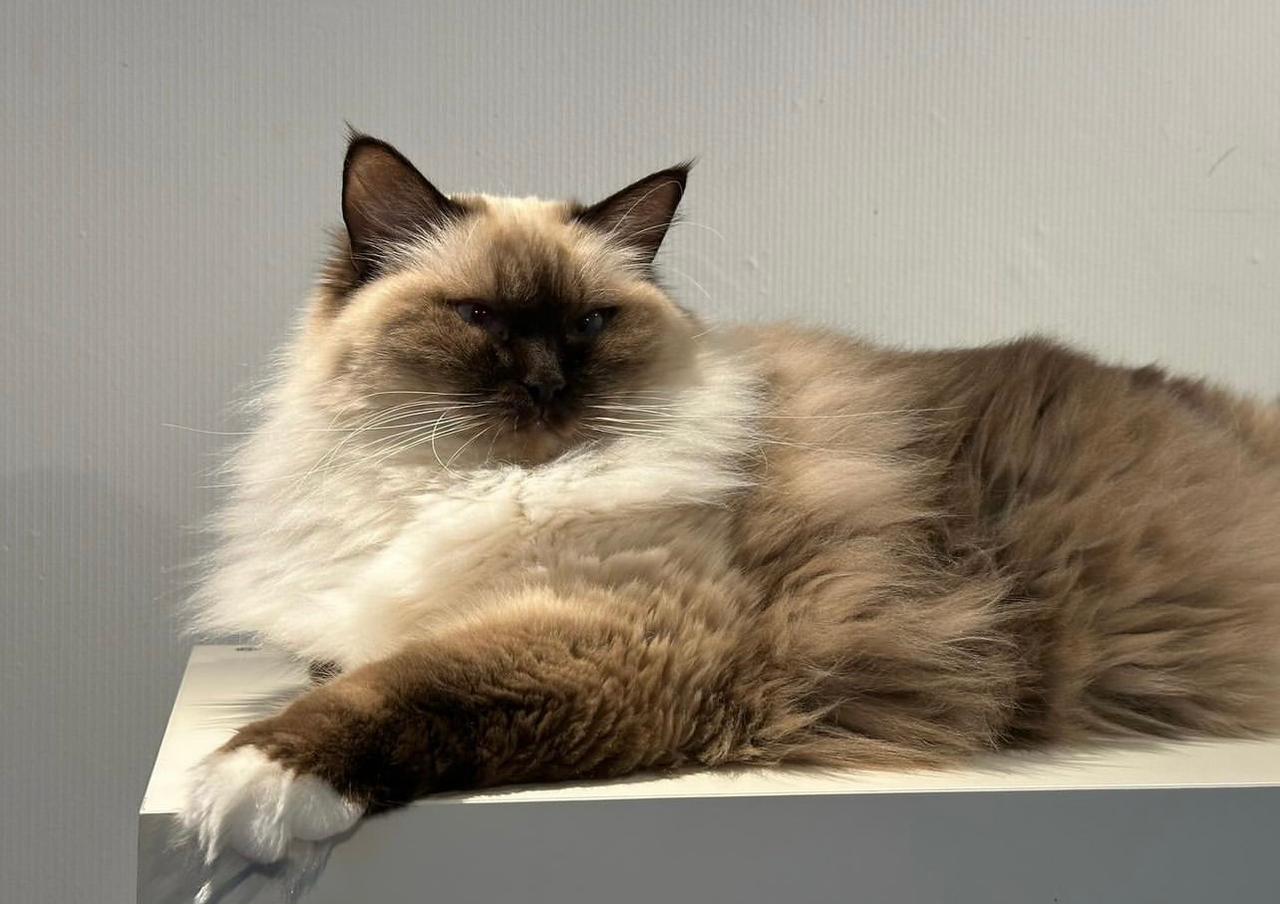After much research about Sepia Ragdoll, we have finally created a list of some amazing facts and features of this breed. Not only this, but we have also studied this breed closely and have found that it has several types. Before jumping to the later part, let us explain what Sepia Ragdoll is so you can differentiate between different breeds easily.
What are Sepia Ragdoll cats?
Sepia Ragdolls are very rare. They are born with a rich, deeper colour than the mink. The Sepia gene originated from the main original Ragdoll line from Ann Baker in 1966. Her cat with the name Buckwheat possessed the Sepia gene.
Sepias are shorter and, compared to other Ragdolls, have an even softer coat colour than other Ragdolls. All the colour variations in the Sepias are the same as in the Traditionals.
Sephia, native to the islands, has blue eyes and dark fur, which becomes darker as they grows older. In an adult Sepia, the usual colour of their eyes is emerald green, aqua blue, or grey.
Ragdoll cats come in eight recognized colors organized by cat organizations (CFA and TICA: seal, blue, chocolate, lilac, red, cream, tortie, and blue-cream. The Sepia Ragdoll specifically can have any of these colors, with the seal being one of the most popular and distinguished hues.
Are Sepia Ragdoll cats rare?
Now, the question that might arise in your mind is whether you can get a Sepia Ragdoll for yourself or not, thinking that they might be rare. If we compare this breed with other ragdoll cats, you’ll be disappointed to hear it is scarce.
Sepia ragdolls can only be bred by two mink ragdolls, and out of an average litter, only 25% are sepia-colored (Rockstar Ragdolls), thus pointing out how rare a sepia ragdoll cat is.
A glimpse of our pet Sepia Ragdoll
We are excited to proudly announce that we have our own Sepia Ragdoll cat named Brownie. Our Brownie had a much darker coat when he was a kitten, and now, at a young age, he has darker points on his face, ears, legs, and tail, just like any other chocolate ragdoll cat. Brownie also has more fur than our chocolate seal point ragdoll named Mr Cookie, though the fur is very fine, creating a problem of entanglement.

Our breeder named them to seal sepia mink ragdoll, and we, too, have found some other names given to this type of Ragdoll, such as chocolate mink ragdoll or sepia colourpoint ragdoll, which can make it quite confusing!
What are the different types of Sepia Ragdoll cats?
Do you know that all sepia Ragdolls are different colours and shades? Here are the main types:
Sepia Colorpoint Ragdoll
In this pattern, the body colour is lighter than the tips of the ears, face, paws, and tail. The difference in the colours of the body and point is not as sharp as in the case of other colour points, hence a lesser gradient.

Sepia Mitted Ragdoll
Sepia Mittens are as coloured as Colorpoints but are equipped with white accents. These cats have white mittens on their paw and a white chin, and frequently, the white stripe on their belly contributes to their looks.

Sepia Bicolor Ragdoll
This pattern has a stronger white and sepia tone than the previous set of patterns. The Bicolor Ragdoll is usually white with a sepia colour on the head, legs, and tail. The white areas can cover a large area of the body and give the rest of the body a dramatic contrast.

All kinds of sepia Ragdolls always retain the friendly personality of the breed and soft cat fur, while their sepia color gives them a special look. On the other hand, Seal sepia ragdolls have different traits.
List of some fantastic traits and characteristics of the Sepia Ragdoll cat
The Sepia Ragdoll cat is one of the most distinct cats belonging to the Ragdoll cat breed, and besides having a fascinating appearance, the cat is friendly. Talking about cat lovers and those who want to become the owner of a new pet, the Sepia Ragdoll will help them get an ordinary cat with a list of parameters that determine its individuality.
Below, you will be presented with some interesting facts and characteristics of this beautiful cat.
1. Distinctive Coloration in Sepia Ragdoll
The Sepia Ragdoll is probably one of the warmest-hued Ragdolls of all, or at least it’s the only warm-featured Ragdoll that seems to us.
Different from other Ragdoll patterns, Sepias have richer, even tones and a splendid color gradient ranging from black on the extremities to lighter on the belly.
This coloring may be attributed to the genes regulating the color distribution, giving Sepia Ragdolls their defining honey-golden/chocolate color.
2. Velvety Soft Fur
Due to the Ragdoll breed standard, the Sepia Ragdoll’s fur is very smooth and glossy. Their coat is medium in length and soft in texture; thus, they do not need regular grooming like most long-coated breeds.
Nevertheless, owing to their size, they are not as likely to mat, so styling the coat is relatively easy. The issues relating to their physical well-being mainly revolve around grooming their coats through daily brushing to maintain hygiene and keep them smooth and shiny.
3. Gentle and Affectionate Nature
These cats are friendly with anybody and can be called Sepia Ragdoll kittens since they are cuddly and tolerant. They are famous for their gentle and pleasant character. They like to be around people, be carried, and be embraced. Their cats’ habit of relaxing almost to a state of limp when being picked up, which is inherent only to the Ragdolls, reflects their trust and obedience.
4. Sociable Companions
These cats are sociable and, therefore, must be with their owners most of the time. They are not very high maintenance, but they do need to be regulated to some degree and engaged with. Sepia Ragdolls are usually very attached to their owners and like to stay with them in all the house rooms; they are friendly with children and other animals, which is good if you have a family.
5. Intelligent and Trainable
It is strongly recommended that Sepia Ragdolls are great with children and intelligent. It is left to understand simple tricks and do well in positive reinforcement training. Their curiosity and desire to be obedient make it possible for them to be receptive to new experiences and challenges regarding the mental and physical aspects, and the fun.
6. Adaptable to various living environments
Due to their rather moderate temperament, Sepia Ragdolls can fit in different conditions of keeping. Regardless of the degree of activity in the house, they adapt well and do not complain. Their docility enables them to cope with a change of schedule or scene without much fuss.
FAQs
What kittens will I get when 2 Mink Ragdolls are bred?
Several people have approached us asking what breed they will get if they breed two mink Ragdolls. We have told them clearly that if they breed one mink doll with another, the kittens they will get will be ¼ mink, ¼ traditional ragdoll kittens, and ½ Sepia Ragdolls.
What kittens will I get when a Sepia Ragdoll is bred?
Well, it will be wrong if we don’t answer this question asked by several people out there. An interstellar thing that you will be shocked to hear is that when a Sepia Ragdoll is bred with traditional Ragdoll cats, the kittens produced will be minks. But when a Sepia Ragdoll is bred with a Mink, you’ll get ½ Sepia and ½ Mink.
Things to remember about Sepia Ragdoll cats
However, coat colors and patterns can differ from one cat to another, and the examples described above are just two possible ones. One also has to mention that Ragdoll kittens are born white, and the coloration is developed gradually and becomes more contrasted with age.
As with all ragdoll cats, no matter the coat type, they require grooming now and then to keep the coat looking shiny; if you own a mink ragdoll cat, be ready to groom it more often with the best ragdoll cat brush.
Sepia Ragdoll cat can be your best companion
If you take good care of it, a sepia ragdoll cat will be the best companion that you have ever wanted and bring you lots of love and a hint of a fairy tale. We have listed this guide, too, and if you are looking to know more about another variation of the ragdoll cat, why not read through our blog on flame point ragdoll cats?

Hey guys, My name is Simon Smith. I’m from Canada and live near Victoria
I live with my sweet family and have 20+ Ragdolls of different types. I love them as my children. My profession is as a hotel manager.
I love to keep Ragdolls and grow their breeder case. I have 7 years of experience.
I’m an expert in cat care. So, I’m here to provide you with new information about my cats daily. This is my blog website, so I request that you kindly visit our site daily.
If you’re a Ragdolls lover and you have any questions or confusion about cats, text me on the Contact Us page or Gmail.
Thank u
